Ram 3500 Chassis Cab 2019 Owner's Manual
Manufacturer: RAM, Model Year: 2019, Model line: 3500 Chassis Cab, Model: Ram 3500 Chassis Cab 2019Pages: 607, PDF Size: 10.72 MB
Page 191 of 607
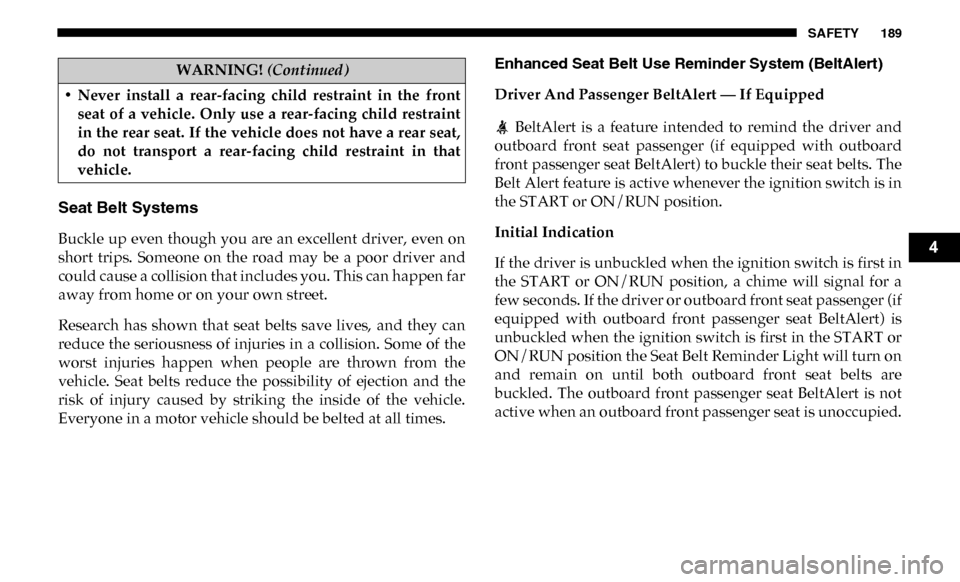
SAFETY 189
Seat Belt Systems
Buckle up even though you are an excellent driver, even on
short trips. Someone on the road may be a poor driver and
could cause a collision that includes you. This can happen far
away from home or on your own street.
Research has shown that seat belts save lives, and they can
reduce the seriousness of injuries in a collision. Some of the
worst injuries happen when people are thrown from the
vehicle. Seat belts reduce the possibility of ejection and the
risk of injury caused by striking the inside of the vehicle.
Everyone in a motor vehicle should be belted at all times.Enhanced Seat Belt Use Reminder System (BeltAlert)
Driver And Passenger BeltAlert — If Equipped
BeltAlert is a feature intended to remind the driver and
outboard front seat passenger (if equipped with outboard
front passenger seat BeltAlert) to buckle their seat belts. The
Belt Alert feature is active whenever the ignition switch is in
the START or ON/RUN position.
Initial Indication
If the driver is unbuckled when the ignition switch is first in
the START or ON/RUN position, a chime will signal for a
few seconds. If the driver or outboard front seat passenger (if
equipped with outboard front passenger seat BeltAlert) is
unbuckled when the ignition switch is first in the START or
ON/RUN position the Seat Belt Reminder Light will turn on
and remain on until both outboard front seat belts are
buckled. The outboard front passenger seat BeltAlert is not
active when an outboard front passenger seat is unoccupied.
• Never install a rear-facing child restraint in the front
seat of a vehicle. Only use a rear-facing child restraint
in the rear seat. If the vehicle does not have a rear seat,
do not transport a rear-facing child restraint in that
vehicle.
WARNING! (Continued)
4
Page 192 of 607
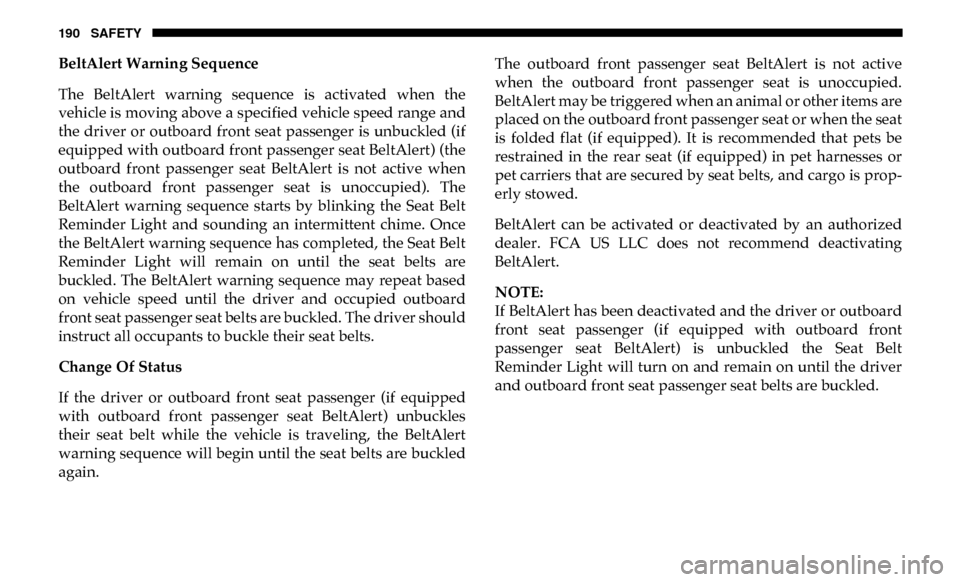
190 SAFETY
BeltAlert Warning Sequence
The BeltAlert warning sequence is activated when the
vehicle is moving above a specified vehicle speed range and
the driver or outboard front seat passenger is unbuckled (if
equipped with outboard front passenger seat BeltAlert) (the
outboard front passenger seat BeltAlert is not active when
the outboard front passenger seat is unoccupied). The
BeltAlert warning sequence starts by blinking the Seat Belt
Reminder Light and sounding an intermittent chime. Once
the BeltAlert warning sequence has completed, the Seat Belt
Reminder Light will remain on until the seat belts are
buckled. The BeltAlert warning sequence may repeat based
on vehicle speed until the driver and occupied outboard
front seat passenger seat belts are buckled. The driver should
instruct all occupants to buckle their seat belts.
Change Of Status
If the driver or outboard front seat passenger (if equipped
with outboard front passenger seat BeltAlert) unbuckles
their seat belt while the vehicle is traveling, the BeltAlert
warning sequence will begin until the seat belts are buckled
again.The outboard front passenger seat BeltAlert is not active
when the outboard front passenger seat is unoccupied.
BeltAlert may be triggered when an animal or other items are
placed on the outboard front passenger seat or when the seat
is folded flat (if equipped). It is recommended that pets be
restrained in the rear seat (if equipped) in pet harnesses or
pet carriers that are secured by seat belts, and cargo is prop
-
erly stowed.
BeltAlert can be activated or deactivated by an authorized
dealer. FCA US LLC does not recommend deactivating
BeltAlert.
NOTE:
If BeltAlert has been deactivated and the driver or outboard
front seat passenger (if equipped with outboard front
passenger seat BeltAlert) is unbuckled the Seat Belt
Reminder Light will turn on and remain on until the driver
and outboard front seat passenger seat belts are buckled.
Page 193 of 607
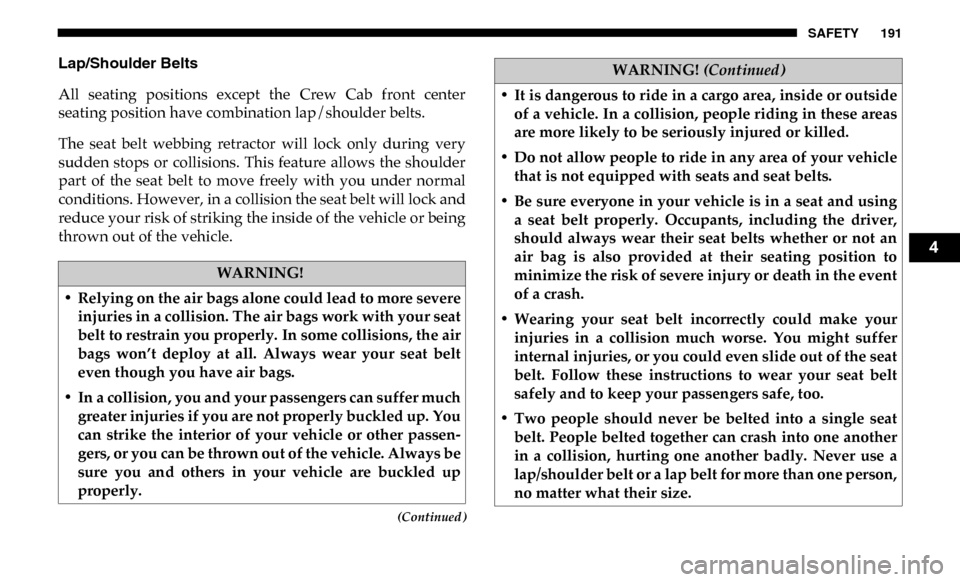
SAFETY 191
(Continued)
Lap/Shoulder Belts
All seating positions except the Crew Cab front center
seating position have combination lap/shoulder belts.
The seat belt webbing retractor will lock only during very
sudden stops or collisions. This feature allows the shoulder
part of the seat belt to move freely with you under normal
conditions. However, in a collision the seat belt will lock and
reduce your risk of striking the inside of the vehicle or being
thrown out of the vehicle.
WARNING!
• Relying on the air bags alone could lead to more severe injuries in a collision. The air bags work with your seat
belt to restrain you properly. In some collisions, the air
bags won’t deploy at all. Always wear your seat belt
even though you have air bags.
• In a collision, you and your passengers can suffer much greater injuries if you are not properly buckled up. You
can strike the interior of your vehicle or other passen -
gers, or you can be thrown out of the vehicle. Always be
sure you and others in your vehicle are buckled up
properly.
• It is dangerous to ride in a cargo area, inside or outside of a vehicle. In a collision, people riding in these areas
are more likely to be seriously injured or killed.
• Do not allow people to ride in any area of your vehicle that is not equipped with seats and seat belts.
• Be sure everyone in your vehicle is in a seat and using a seat belt properly. Occupants, including the driver,
should always wear their seat belts whether or not an
air bag is also provided at their seating position to
minimize the risk of severe injury or death in the event
of a crash.
• Wearing your seat belt incorrectly could make your injuries in a collision much worse. You might suffer
internal injuries, or you could even slide out of the seat
belt. Follow these instructions to wear your seat belt
safely and to keep your passengers safe, too.
• Two people should never be belted into a single seat belt. People belted together can crash into one another
in a collision, hurting one another badly. Never use a
lap/shoulder belt or a lap belt for more than one person,
no matter what their size.
WARNING! (Continued)
4
Page 194 of 607
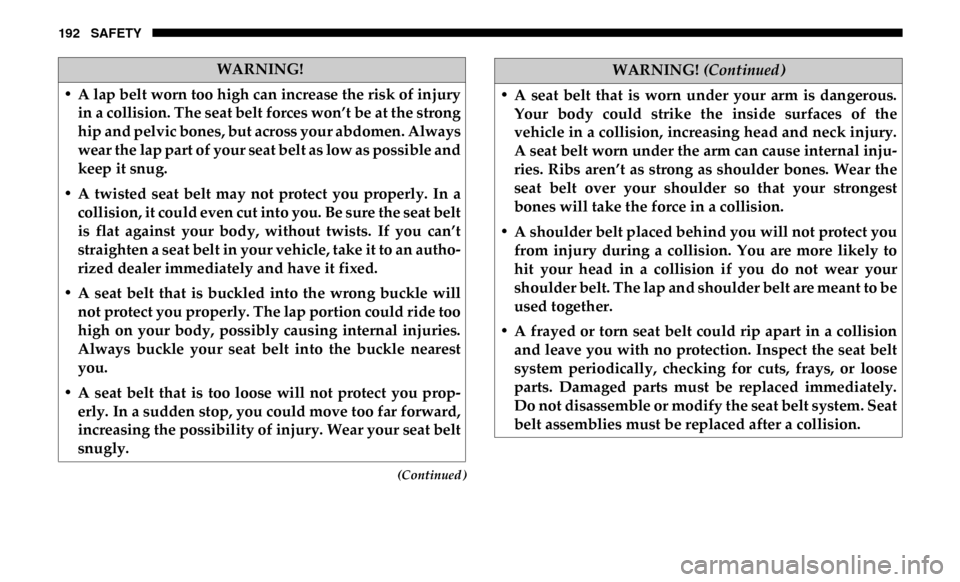
192 SAFETY
(Continued)
WARNING!
• A lap belt worn too high can increase the risk of injury in a collision. The seat belt forces won’t be at the strong
hip and pelvic bones, but across your abdomen. Always
wear the lap part of your seat belt as low as possible and
keep it snug.
• A twisted seat belt may not protect you properly. In a collision, it could even cut into you. Be sure the seat belt
is flat against your body, without twists. If you can’t
straighten a seat belt in your vehicle, take it to an autho -
rized dealer immediately and have it fixed.
• A seat belt that is buckled into the wrong buckle will not protect you properly. The lap portion could ride too
high on your body, possibly causing internal injuries.
Always buckle your seat belt into the buckle nearest
you.
• A seat belt that is too loose will not protect you prop -
erly. In a sudden stop, you could move too far forward,
increasing the possibility of injury. Wear your seat belt
snugly.
• A seat belt that is worn under your arm is dangerous. Your body could strike the inside surfaces of the
vehicle in a collision, increasing head and neck injury.
A seat belt worn under the arm can cause internal inju -
ries. Ribs aren’t as strong as shoulder bones. Wear the
seat belt over your shoulder so that your strongest
bones will take the force in a collision.
• A shoulder belt placed behind you will not protect you from injury during a collision. You are more likely to
hit your head in a collision if you do not wear your
shoulder belt. The lap and shoulder belt are meant to be
used together.
• A frayed or torn seat belt could rip apart in a collision and leave you with no protection. Inspect the seat belt
system periodically, checking for cuts, frays, or loose
parts. Damaged parts must be replaced immediately.
Do not disassemble or modify the seat belt system. Seat
belt assemblies must be replaced after a collision.
WARNING! (Continued)
Page 195 of 607
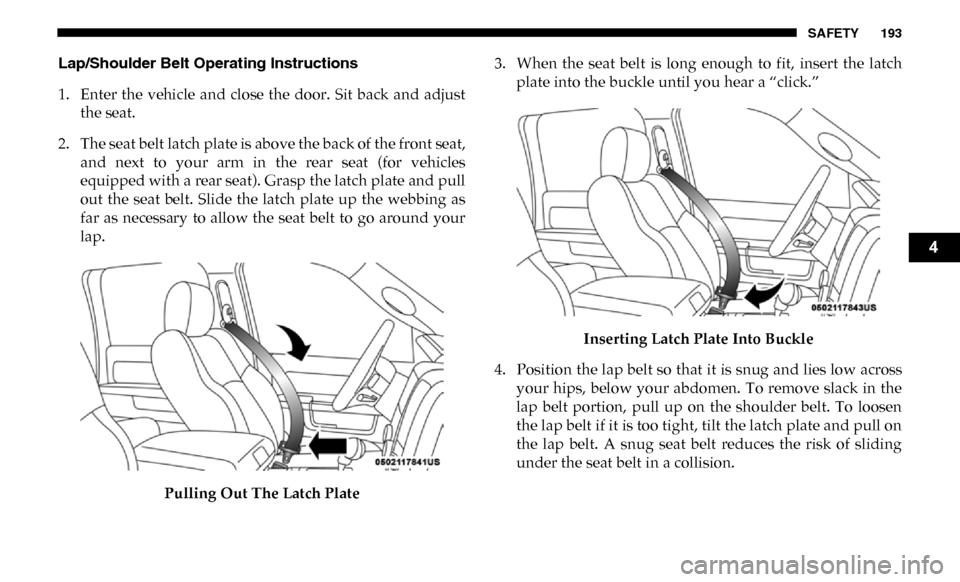
SAFETY 193
Lap/Shoulder Belt Operating Instructions
1. Enter the vehicle and close the door. Sit back and adjustthe seat.
2. The seat belt latch plate is above the back of the front seat, and next to your arm in the rear seat (for vehicles
equipped with a rear seat). Grasp the latch plate and pull
out the seat belt. Slide the latch plate up the webbing as
far as necessary to allow the seat belt to go around your
lap.
Pulling Out The Latch Plate 3. When the seat belt is long enough to fit, insert the latch
plate into the buckle until you hear a “click.”
Inserting Latch Plate Into Buckle
4. Position the lap belt so that it is snug and lies low across your hips, below your abdomen. To remove slack in the
lap belt portion, pull up on the shoulder belt. To loosen
the lap belt if it is too tight, tilt the latch plate and pull on
the lap belt. A snug seat belt reduces the risk of sliding
under the seat belt in a collision.
4
Page 196 of 607
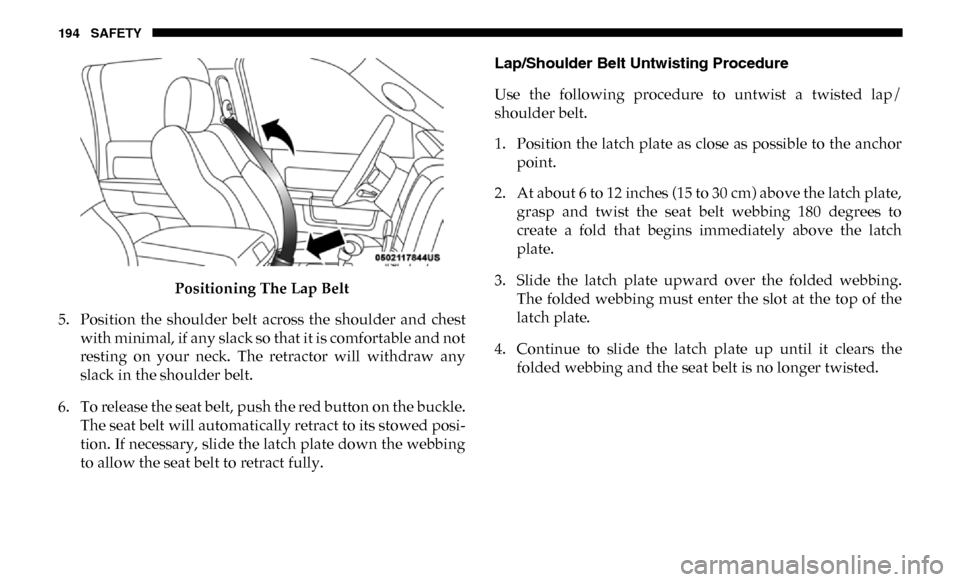
194 SAFETY
Positioning The Lap Belt
5. Position the shoulder belt across the shoulder and chest with minimal, if any slack so that it is comfortable and not
resting on your neck. The retractor will withdraw any
slack in the shoulder belt.
6. To release the seat belt, push the red button on the buckle. The seat belt will automatically retract to its stowed posi -
tion. If necessary, slide the latch plate down the webbing
to allow the seat belt to retract fully. Lap/Shoulder Belt Untwisting Procedure
Use the following procedure to untwist a twisted lap/
shoulder belt.
1. Position the latch plate as close as possible to the anchor
point.
2. At about 6 to 12 inches (15 to 30 cm) above the latch plate, grasp and twist the seat belt webbing 180 degrees to
create a fold that begins immediately above the latch
plate.
3. Slide the latch plate upward over the folded webbing. The folded webbing must enter the slot at the top of the
latch plate.
4. Continue to slide the latch plate up until it clears the folded webbing and the seat belt is no longer twisted.
Page 197 of 607
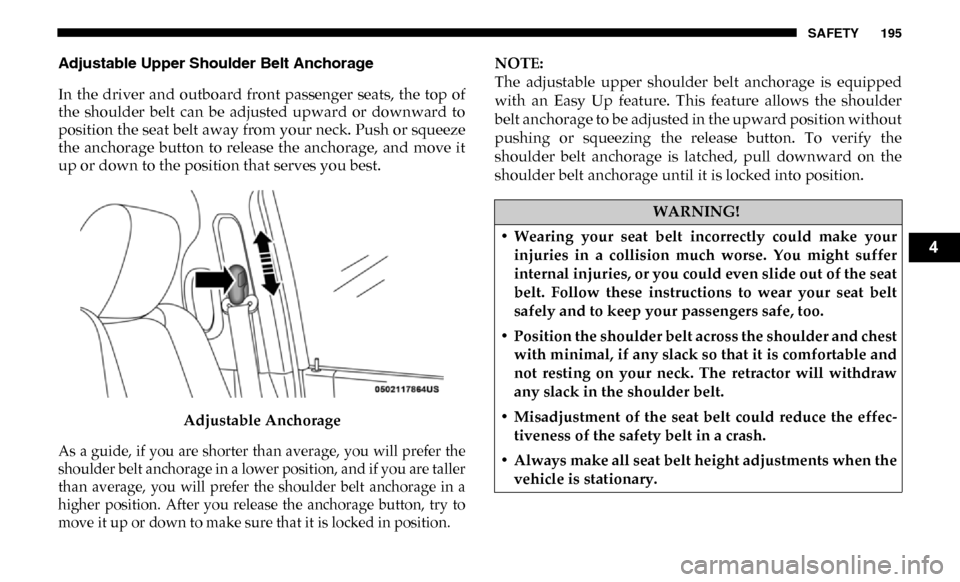
SAFETY 195
Adjustable Upper Shoulder Belt Anchorage
In the driver and outboard front passenger seats, the top of
the shoulder belt can be adjusted upward or downward to
position the seat belt away from your neck. Push or squeeze
the anchorage button to release the anchorage, and move it
up or down to the position that serves you best.Adjustable Anchorage
As a guide, if you are shorter than average, you will prefer the
shoulder belt anchorage in a lower position, and if you are taller
than average, you will prefer the shoulder belt anchorage in a
higher position. After you release the anchorage button, try to
move it up or down to make sure that it is locked in position.
NOTE:
The adjustable upper shoulder belt anchorage is equipped
with an Easy Up feature. This feature allows the shoulder
belt anchorage to be adjusted in the upward position without
pushing or squeezing the release button. To verify the
shoulder belt anchorage is latched, pull downward on the
shoulder belt anchorage until it is locked into position.
WARNING!
• Wearing your seat belt incorrectly could make your injuries in a collision much worse. You might suffer
internal injuries, or you could even slide out of the seat
belt. Follow these instructions to wear your seat belt
safely and to keep your passengers safe, too.
• Position the shoulder belt across the shoulder and chest with minimal, if any slack so that it is comfortable and
not resting on your neck. The retractor will withdraw
any slack in the shoulder belt.
• Misadjustment of the seat belt could reduce the effec -
tiveness of the safety belt in a crash.
• Always make all seat belt height adjustments when the vehicle is stationary.
4
Page 198 of 607
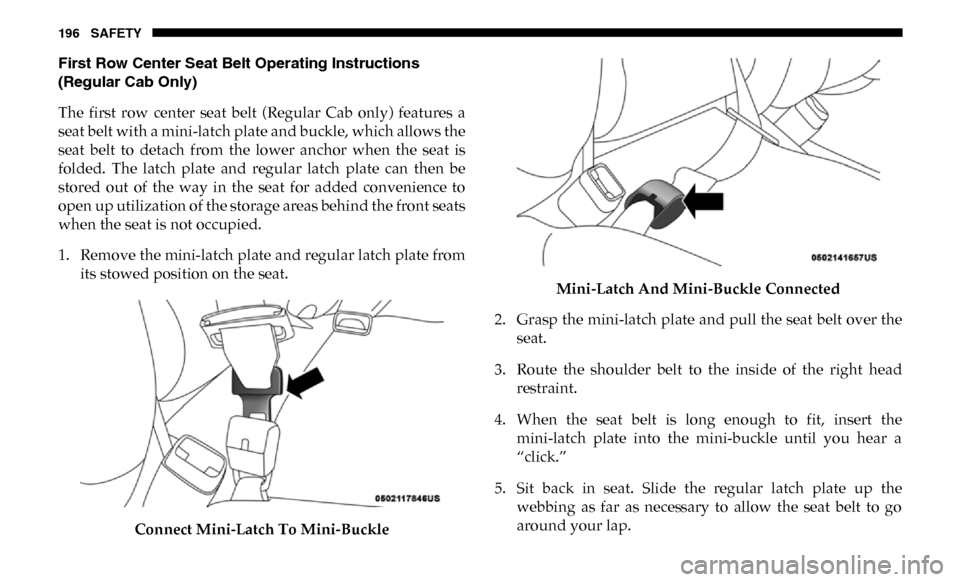
196 SAFETY
First Row Center Seat Belt Operating Instructions
(Regular Cab Only)
The first row center seat belt (Regular Cab only) features a
seat belt with a mini-latch plate and buckle, which allows the
seat belt to detach from the lower anchor when the seat is
folded. The latch plate and regular latch plate can then be
stored out of the way in the seat for added convenience to
open up utilization of the storage areas behind the front seats
when the seat is not occupied.
1. Remove the mini-latch plate and regular latch plate fromits stowed position on the seat.
Connect Mini-Latch To Mini-Buckle Mini-Latch And Mini-Buckle Connected
2. Grasp the mini-latch plate and pull the seat belt over the seat.
3. Route the shoulder belt to the inside of the right head restraint.
4. When the seat belt is long enough to fit, insert the mini-latch plate into the mini-buckle until you hear a
“click.”
5. Sit back in seat. Slide the regular latch plate up the webbing as far as necessary to allow the seat belt to go
around your lap.
Page 199 of 607
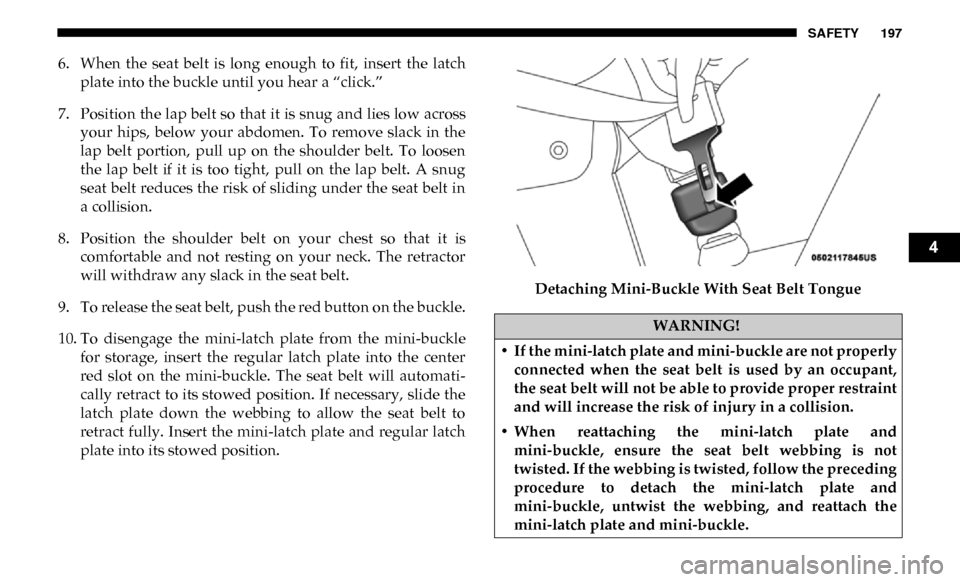
SAFETY 197
6. When the seat belt is long enough to fit, insert the latchplate into the buckle until you hear a “click.”
7. Position the lap belt so that it is snug and lies low across your hips, below your abdomen. To remove slack in the
lap belt portion, pull up on the shoulder belt. To loosen
the lap belt if it is too tight, pull on the lap belt. A snug
seat belt reduces the risk of sliding under the seat belt in
a collision.
8. Position the shoulder belt on your chest so that it is comfortable and not resting on your neck. The retractor
will withdraw any slack in the seat belt.
9. To release the seat belt, push the red button on the buckle.
10. To disengage the mini-latch plate from the mini-buckle for storage, insert the regular latch plate into the center
red slot on the mini-buckle. The seat belt will automati -
cally retract to its stowed position. If necessary, slide the
latch plate down the webbing to allow the seat belt to
retract fully. Insert the mini-latch plate and regular latch
plate into its stowed position. Detaching Mini-Buckle With Seat Belt Tongue
WARNING!
• If the mini-latch plate and mini-buckle are not properly connected when the seat belt is used by an occupant,
the seat belt will not be able to provide proper restraint
and will increase the risk of injury in a collision.
• When reattaching the mini-latch plate and mini-buckle, ensure the seat belt webbing is not
twisted. If the webbing is twisted, follow the preceding
procedure to detach the mini-latch plate and
mini-buckle, untwist the webbing, and reattach the
mini-latch plate and mini-buckle.
4
Page 200 of 607
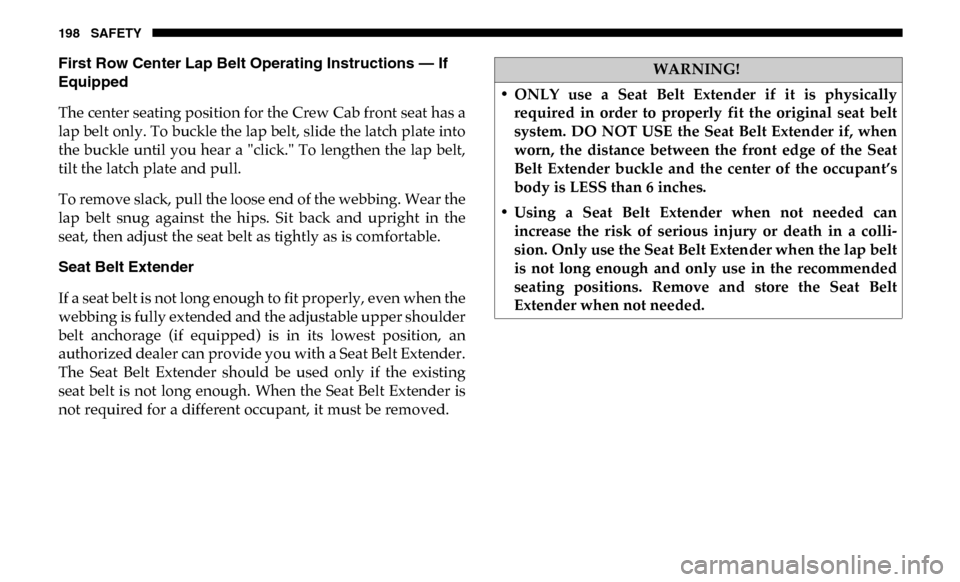
198 SAFETY
First Row Center Lap Belt Operating Instructions — If
Equipped
The center seating position for the Crew Cab front seat has a
lap belt only. To buckle the lap belt, slide the latch plate into
the buckle until you hear a "click." To lengthen the lap belt,
tilt the latch plate and pull.
To remove slack, pull the loose end of the webbing. Wear the
lap belt snug against the hips. Sit back and upright in the
seat, then adjust the seat belt as tightly as is comfortable.
Seat Belt Extender
If a seat belt is not long enough to fit properly, even when the
webbing is fully extended and the adjustable upper shoulder
belt anchorage (if equipped) is in its lowest position, an
authorized dealer can provide you with a Seat Belt Extender.
The Seat Belt Extender should be used only if the existing
seat belt is not long enough. When the Seat Belt Extender is
not required for a different occupant, it must be removed.WARNING!
• ONLY use a Seat Belt Extender if it is physically required in order to properly fit the original seat belt
system. DO NOT USE the Seat Belt Extender if, when
worn, the distance between the front edge of the Seat
Belt Extender buckle and the center of the occupant’s
body is LESS than 6 inches.
• Using a Seat Belt Extender when not needed can increase the risk of serious injury or death in a colli -
sion. Only use the Seat Belt Extender when the lap belt
is not long enough and only use in the recommended
seating positions. Remove and store the Seat Belt
Extender when not needed.